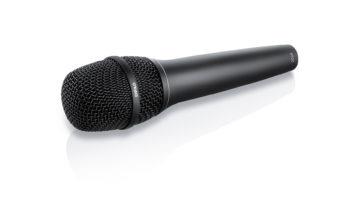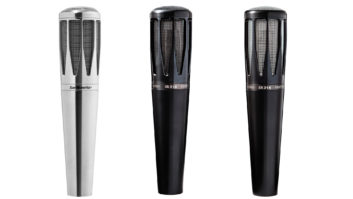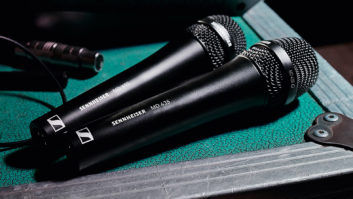
Though images of large diaphragm condenser (LDC) microphones often represent the glamour of capturing vocals in the studio, handheld vocal microphones often remind us of the work involved in translating a live vocal. Handheld mics can be a lot of things—they are usually dynamic models, though increasing numbers of condensers are available today, too—some with switchable polar patterns and rather advanced features. And soon they’re also most always abused and often smelly from spit and sweat. Even a diva’s highest-end handheld with, for example, custom rhinestones is, at the end of the day, a workhorse; it will stay pretty for only so long.
Between my collaborative work as Reviews Editor for NewBay Media and lots of live gigging over the years, I’ve had the opportunity to use and review a wide range of handheld dynamics and condensers, sharing and receiving insight through a range of peers and performers. If anything, I’ve found that a wired handheld vocal mic is most appealing to discriminating audio engineers when it provides at least a little something else that our standard—quite often Shure’s ubiquitous SM58 dynamic—does not. Rarely are these glamorous features, mind you, just very useful ones in the “one shot” world of live sound.
Each of the microphones listed below are worthwhile choices, though price range and performance characteristics do vary significantly between them. As such, this top eight list of notable handheld vocal microphones is in alphabetical order, while prices vary from $99 to $999 street.
Audix OM7
Hypercardioid Dynamic Microphone ($229 street)
Fans of American-made Audix microphones have long attested to the brand’s value and roadworthiness; personally, I’ve depended on a pair of i5 dynamic instrument mics for years, which are all-around workhorses that I’m happy to use on most any gig. Among its product line, Audix’s OM7 is most often referenced as the company’s notably flexible, great sounding live vocal dynamic. It provides good off-axis rejection thanks to its tight polar pattern, handles up to 144dB SPL, and its rather sculpted frequency response—with significant bumps at 50 to 200 Hz and hills ranging from flat to +7 dB from 1 to 5 kHz—essentially acts as well-selected EQ at the source. The OM7 is designed with an unconventionally low output level, which is 8 to 10 dB lower than typical dynamic microphones. While the mic doesn’t have a built-in pad, this design feature acts as a natural attenuation allowing you to feed it higher SPL sources. Of course the low output level calls for an excellent preamp at the console or rack to be sure you’re not adding noise from your gain stage.

Blue enCORE 200
Cardioid Active Dynamic Microphone ($150 street)
In commissioning reviews among pro-level contributors whom I regularly worth with, I’ve had the opportunity to pick the brains of two engineers about the Blue enCORE 200: Rob Tavaglione, who is based primarily in the studio, and Will James Leach, who works in shed/theater-level live sound. Both engineers raved about this microphone.
Hitting the local Guitar Center in a pinch while on his way to a location recording date, Tavaglione conducted a quick six-model higher-end vocal handheld shootout in the store’s demo room. He left with the enCORE 200. “It features a proprietary Active Dynamic Circuit requiring 48-volt phantom power,” explains Tavaglione. “The circuit drives the mic output, assuring consistency no matter the cable length, according to Blue.”
For Tavaglione’s live vocal needs, “the enCORE 200’s mids had a desirable, rich forwardness that was still closer to flat than colorful,” but with a slightly rolled-off, notably clean bottom end “resulting in EQ balanced that seemed right on point.” Later, back in the studio, Tavaglione employed it on a Johnny Cash–type vocalist for scratch vocals. The vocalist fell in love and ultimately bought an enCORE 200, as well. “He said, ‘This is the way I want my vocals to sound in the monitors live,’” recalls Tavaglione. “I received tones and performances on par with my ‘real studio mics,’ and the vocalist might just keep that scratch!”

DPA Microphones d:facto II
Handheld Vocal Microphone ($979 street)
DPA’s d:facto line was a notable announcement for the company, as it was DPA’s foray into the product category of handheld vocal microphones. In reviewing the d:facto II supercardioid condenser, Will James was quite impressed, first noting its virtually non-existent handling noise, superb durability and build quality. Switching the d:facto II into lead vocal position for a one-off gig with Chubby Checker, James found it to be “notably smooth with a very nice, open character, able to attain very high output levels while leaving my system’s graphic EQ comparably flat.” James soon found other notable artists who were quite willing to audition the d:facto II, too.
The d:facto II features a matte black aluminum finish, triple pop filter screen and a rather broad, flat 20 to 20k Hz frequency response. It also boasts extreme SPL handling ability, maxing out at 160 dB. One great extra is d:facto II’s compatibility with popular existing wireless systems. The mic can be used with more than 20 systems from Sony, Lectrosonics, Line 6, Shure, Wisycom and Sennheiser. Accessories include a mic clip, foam windscreen for reducing plosives, and microphone grids in gold, black, and nickel finishes.

Earthworks SR40V
Vocal Condenser Microphone ($999 street)
Another premium microphone manufacturer delving into handheld condensers is Earthworks with its SR40V. A hypercardioid model, the SR40V served engineer/producer and composer Rich Tozzoli very well as his primary vocal microphone for one of his annual recording retreats in St. John, USVI; each year, he travels south with good musician friends and only a smattering of gear, returning with collaborative recorded efforts that the rest of us may ultimately hear on programs including the History Channel’s Pawn Stars, A&E’s Duck Dynasty, etc.—regular composing gigs for Tozzoli.
In 2014, Tozzoli reported that the SR40V is “an exceptional microphone for stage use,” and that since it’s a “fact that it’s also right at home in the studio, the SR40V is well worth that price. This is one of those mics you have to hear for yourself; once you do, the appeal of the SR40V becomes self-explanatory.”
Notable features of the SR40V include a stainless steel chassis; a reported frequency range of 30 to 40k Hz with low handling noise; a self-noise rating of 22dB SPL (A-weighted); and a 145dB maximum SPL. Available accessories include the MC4 microphone clip and the SR40V-C traveling case with a custom foam insert.

Electro-Voice PL80a
Supercardioid Dynamic Vocal Microphone ($99 street)
It’s not a very widely known dynamic handheld, but Electro-Voice’s PL80a is my favorite affordable vocal mic I’ve ever used. With a comparably limited reported frequency response (80 to 16k Hz), it captures everything I need in a live vocal and even works well on other instruments onstage and in the studio, too; I’ve had incredible luck with it on snare drum and guitar amp.
Perhaps its appeal is due to a variety of notable design elements, including its well-sculpted EQ curves, which create a silky and rich midrange, and even the way it looks on a stand and feels in the hand. I’ve used vocal microphones many times more expensive than the PL80a, only to wish I had it in my gig bag. Thus I rarely leave home to gig without it anymore. At $99, it’s my favorite vocal mic bargain. Available accessories include the SAPL-1 mic stand adapter, and the WSPL-1 foam windscreen. There is also an option to order the mic in the classic PL beige finish named the PL80c.

Neumann KMS 105
Supercardioid Condenser Microphone ($700 street)
The KMS 104—a cardioid condenser handheld specially built for pro-grade vocal use—is one of the first “premium handheld” condensers I can remember receiving for review. Upon sharing with our intrigued live sound contributors (who finally had “their Neumann”) it immediately became a personally impressive performer, as the buzz was spreading elsewhere around the industry, too. Engineers who used it immediately compared it to worthwhile condenser choices for vocals in the studio, which of course for some meant a learning curve, or a new approach to their normal treatment of live lead vocals.
However, if there was an early criticism of the KMS 104, it seemed to be amongst users on louder stages and was associated with a need for more off-axis rejection.
The KMS 105 was the answer to that need: a supercardioid version, available in either nickel or matte black finish. Additionally, the KMS 105 features a fixed built-in HPF at 120 Hz and handles up to 150dB SPL. The series comes with numerous accessories including battery power supplies, shock- and stand mounts, table stands, power supply, cables, floor stands and adapter cables.

Sennheiser e 965
Dual-Pattern Handheld Condenser Microphone ($699 street)
Much like its Neumann sibling, the e 965 resides at the top of live handheld marketplace, and brings some uniquely alluring features to the category, like a large 1-inch diaphragm and switchable cardioid and supercardioid polar patterns. The idea of switchable patterns in live handheld microphones optimized for vocals means users can adapt the mic to its surroundings. In situations where leakage from other instruments is not a factor, the use of the cardioid pattern would mean a wider “sweet spot” when the mic is off axis. In applications where noisy neighbors are in play, the mic’s super-cardioid pattern allows the engineer to isolate the microphone better allowing for a cleaner feed from the source. Other features include a low self-noise rating of 21dB SPL (A-weighted) and—like the entire Evolution line—markedly rugged and road-worthy build quality. A low-cut switch reduces ambient noise, rumble and wind noise. Other extras include a switchable -10dB pad, a built-in shock-mount for rejecting handling noise, protection against moisture, a frequency response of 40 to 20k Hz, and a 10-year warranty.

Shure KSM9HS
Dual-Pattern Handheld Condenser Microphone ($699 street)
Also at $699 street—the same price as the previously mentioned cardioid/supercardioid Sennheiser e 965—Shure’s KSM9HS offers selectable hypercardioid (more directional than the supercardioid setting) and subcardioid (a rounder polar pattern, less directional than the KSM9 cardioid setting) patterns, and a 150dB-plus maximum SPL handling ability. Maximum off-axis rejections are at 110 and 180 degrees, hypercardioid and subcardioid settings, respectively.
In my own review, I found the KSM9HS’s subcardioid flatter in frequency response across a wider portion of the band, with lower frequency extension; its hypercardioid is pretty flat out to 20 kHz. The subcardioid never drops below zero at around 2 kHz—a slight shelf in effect. Overall the mic delivers a crisp, immediate sound, one perfect for allowing vocals to pop forward in an attractive sheen, which I found especially desirable and useful in crowded live mixes, for example. The KSM9HS features consistency across a broad range of frequencies, meaning more gain before feedback, which results in a reduction of the proximity effect. Other components include a dual gold layered, low-mass Mylar diaphragm, and Class-A transformer preamp circuitry. The KSM9HS is available as wireless handheld transmitter SKUs.
Rich Tozzoli brought my same KSM9HS review unit to St. John as his 2015 recording retreat’s main vocal microphone. If I recall correctly, I’m pretty sure he told me that I’d never see it again.
Strother Bullins is Reviews Editor for NewBay Media’s AV/Pro Audio Group, an active musician, self-recordist and club-level live sound wrangler. Contact him at [email protected].







